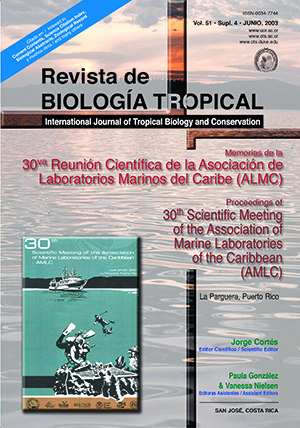Resumen
Se aislaron varias bacterias de las islas de Puerto Rico, Vieques y Trinidad por su actividad de degradar carbohidratos. Estas bacterias terrestres y marinas fueron colectadas de suelos para cultivo de piña, bosque lluvioso tropical, costas y pantanos de manglar. Utilizando sustratos de carbohidratos con enlaces cromogénicos (AZCL® Megazyme International Ltd., Ireland) se seleccionaron aquellos organismos que poseían actividad. La composición del medio para el cultivo efectivo de los organismos marinos fue estandarizada. Organismos Gram negativo fueron identificados por análisis de secuencia de la amplificación parcial por PCR del gen 16S de la subunidad pequeña del ARNr. Los resultados indican que la mayoría de los organismos marinos estudiados pertenecen al género Vibrio y Pseudoalteromonas y que en los ambientes terrestres predominó Chryseobacterium. Estos experimentos revelaron que los ambientes subtropicales son potencialmente buenas fuentes de microorganismos con novedosas actividades de carbohidrasas.Citas
Altman, P.L. & D.S. Dittmar. 1966. Environmental Biology. Fed. Amer. Soc. Exper. Biol. Bethesda, Maryland. 456 p.
Altschul, S.F., W. Gish, W. Miller, E.W. Myers & D.J. Lipman. 1990. Basic local alignment search tool. J. Mol. Biol. 215: 403-410.
Ausubel, F.M., R. Brent, R.E. Kingston, D.D. Moore, J.G. Siedman, J.A. Smith & K. Struhl. 1995. Short Protocols in molecular biology. Wiley. 2.11-2.12 p.
Burkholder, P.R. 1963. Some nutritional requirements between microbes of the sea sediments and waters. p. 133-150. In Symposium on marine microbiology. Operhimer C.H. C.C. Thomas. Springfield, III.
Costerton, J.W., J.W. Ingram. & K.J. Cheng. 1974. Structure and function of the cell envelope of gramnegative bacteria. Bact. Rev. 38: 87-110.
Franqui, D.E. 2001. Characterization and purification of starch degrading enzymes from a marine bacterium. M.S. Thesis, Univ. Puerto Rico, Mayaguez, Puerto Rico. 84 p.
Gilbert, H.J. & G.P. Hazlewood. 1991. Genetic modification of fiber digestion. Proc. Nutr. Soc. 50: 173-186.
Greene, R.V. & S.N. Freer. 1986. Growth characteristics of a novel nitrogen-fixing cellulolytic bacterium. Appl. Environ. Microbiol. 52: 982-986.
Himmel, M., W. Adney, J. Baker, R. Elander, J. McMillan, R. Nieves, J. Sheehan, S. Thomas, T. Vizant & M. Zhang. 1997. Advanced bioethanol production technologies: a perspective. p. 1-45. In S. Badal & J. Woodward (eds.). Symposium Series 666, Amer. Chem. Soc. Washington, DC.
Johnson, E.A., M. Sakojoh, G. Halliwell, A. Madia & A.L. Demain. 1982. Saccharification of complex cellulosic substrates by the cellulase of Clostridium thermocellum. Appl. Environ. Microbiol. 43: 1125-1132.
Kubicek, C.P., R. Messner, F. Gruber, R.L. Mach & E.M. Kubicek-Pranz. 1993. The Trichoderma cellulase regulatory puzzle: From the interior life of a secretory fungus. Enz. Microb.Technol. 15: 90-99.
Lamed, R. & E.A. Bayer. 1988. The cellulosome of Clostridium thermocellum. Adv. Appl. Microbiol. 33: 146.
Leathers T.D., N.S. Govind & R.V.Greene. 2000. Biodegradation of poly (3-hydroxybutyrate-co-3-hydrovalerate) by a tropical marine bacterium, Pseudoalteromonas sp. NRRLB-30083. J. Polymers. Environ. 8: 119-124.
Oliver, J.D. 1993. Formation of viable but unculturable cells: p. 239-272. In . S. Kjelleberg (ed.). Starvation in Bacteria. Plenum, New York.
Rao, M. B., A.M. Tanksale, M.S. Ghatge & U.V. Deshpande. 1998. Molecular and biotechnological aspects of microbial proteases. Microbiol. Mol. Biol. Rev. 62: 597-635.
Stackebrandt, E. & B.M. Goebel. 1994. Taxonomic note: A place for DNA-DNA reassociation and 16SrRNA sequence analysis in the present species definition in bacteriology. Int. J. Syst. Bacteriol. 44: 846-849.
Teeri, T.T. 1997. Crystalline cellulose degradation: new insight into function of cellobiohydrolases. Trends in Biotechnol. 15: 160-167.
Tiedje, J.M. 1994. Microbial diversity: Of what value to whom? ASM News 60: 524-525.
##plugins.facebook.comentarios##

Esta obra está bajo una licencia internacional Creative Commons Atribución 4.0.
Derechos de autor 2003 Revista de Biología Tropical


